Name
English Meaning |
Image |
Description
atha dvātriṁshadgaṇapatInāṁ dhyānaṁ || mudgalapurāṇe ||
|
Bāla Gaṇapati
"Childlike Ganapati"
|

|
tatra bālagaṇapatidhyānaṁ
karasthakadalīcūta | panasekṣucamodakaṁ | bālasūryanibhaṁ vaṁde
||
devaṁ bālagaṇādhipaṁ || 1 || raktavarṇaḥ
Adorned with a garland of tender flowers, having plantain (banana), mango, jack fruit, sugarcane and sweets (modaka) in His hands and who is effulgent like the rising sun [7] (red color).
|
Taruṇa Gaṇapati
"Youthful Ganapati"
|

|
atha taruṇagaṇapatidhyānaṁ || mudgalapurāṇe ||
pāshāṁkushāpūpakapitthajaṁbū |
svadaṁtaśālīkṣumapi svahastaiḥ |
dhatte sadāyastaruṇāruṇābhaḥ |
pāyātsa yuṣmāṁstaruṇogaṇeshaḥ || 2 || raktavarṇaḥ
"Carrying in His hands the noose, hook, rice-cake, guava fruit, rose apple, own (broken) tusk, bunch of corn ears (paddy) and sugarcane and who vividly shines forth with His brilliant youthfulness"[8] (Red Color).
(According to the Mudgala Purana version, kadubu - an edible specific to Lord Ganapati is mentioned instead of rice-cake).
|
Bhakti Gaṇapati
"Devotee (Devotion) Ganapati"
|

|
atha bhaktagaNapatidhyAnaM || mudgalapurANE |
nArikELAmrakadaLI |
guDapAyasadhAriNaM |
sharaccaMdrAbhavapuShaM |
bhajE bhaktagaNAdhipaM ||3|| shvEtavarNaH
Described as “ the Lord of His devotees and who shines like the autumn moon, with coconut, mango, plantain (banana), jaggery and sweets in his hands."[9]
(White Colour)
|
Vīra Gaṇapati
"Valiant Ganapati"
|

|
atha vIragaNapatidhyAnaM || mudgalapurANE ||
bhEtALashaktisharakAr^mukacakraKaDga |
KaTvAMgamudgaragadAMkushanAgapAshAn |
shUlaM ca kuMtaparashuM dhvajamudvahaMtaM |
vIraM gaNEshamaruNaM satataM smarAmi ||4 || rakatavarNaH
"Armed with Bhetala, the weapon of power(shakti), arrow, bow, wheel(Chakra or discus), sword, club, hammer, mace, hook, nagapasha (serpent noose), spear, plough, and the shining axe."[10] (Red Colour).
(According to the Mudgala Purana version, flag is mentioned instead of plough).
|
Śakti Gaṇapati
The "Powerful" Ganapati
|
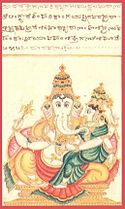
|
atha shaktigaNapatidhyAnaM || mudgalapurANE ||
AliMgya dEvIM haritAMgayaShTiM |
parasparAshliShTakaTipradEshaM |
saMdhyAruNaM pAshasRuNI vahaMtaM |
bhayApaham Sakti ganESameeDE |
He is red in colour. He has four arms. His low right hand shows the movement of lack of fear (abhaya); the two others wear the elephant goad and the noose; the last hand, who holds a lemon, embraces the goddess. With the top of his trunk, Shakti Ganapati holds a cake.
|
Dvija Gaṇapati
"Ganapati the Twice-Born"
|

|
atha dvijagaNapatidhyAnaM || mudgalapurANE ||
yaM pustukAkShaguNadaMDakamaMDala shrIvidyOtamAnakarabhUShaNa miMduvarNaM |
staMbEramAnanacatuShTayashObhamAnaM |
tvAM yaH smarEddvijagaNAdhipatE sadhanyaH ||6|| shubhravarNaH
He has four heads and four arms. He is white in colour. His hands hold the rosary, the washing pot (kamandalu), the walking-stick of an ascetic or the ritual spoon (sruk) and the manuscript on palm-leaves (pustaka).
|
Siddhi Gaṇapati
Ganapati bestowing success(Siddhi)
or "The Accomplished Ganapati"
|

|
atha siddhagaNapatidhyAnaM || mudgalapurANE ||
pakvacUtaPalapuShpamaMjarI |
mikShudaMDatilamOdakaisvaha |
udvahanvarashumastu tE namashrI samRuddhiyutahEmapiMgaLa ||7|| piMgaLavarNaH
Fond of the sesame cake. He has four arms. He is golden in colour. His hands hold the axe, the noose, the sugar-cane stem and the mango.
|
Ucçhishṭa Gaṇapati
"Ganapati devouring the remnants of the meal"
|

|
atha uCiShTagaNapatidhyAnaM || mudgalapurANE ||
nīlābjadāḍimīvīṇā śālīguṁjākṣasūtrakaṁ ǀ
dadhaducciṣṭanāmāyaṁ gaṇēśaḥ pātu mēcakaḥ ǁ
graṁthāṁtare |
nārīyōnirasāsvada |
lōlupaṁ kāmamōhitamiti ||8|| nīlavarṇaḥ
He has six arms. He is blue in colour. His hands show the rosary, the pomegranate, the paddy ear (shalyagra), the nocturnal lotus, the lute (vîna); his sixth hand sometimes bears a guñja berry, embraces the goddess. The Ucchista Ganapati trunk is placed on the goddess's thigh.[citation needed]
|
Vighna Gaṇapati
Ganapati - "Lord of Obstacles"
|
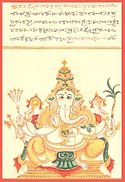
|
atha viGnagaNapatidhyAnaM || mudgalapurANE ||
shaMKEkShucApakusumEShukuThArapAsha |
cakrasvadaMtasRuNimaMjarikAshanAdaiH |
pANishritaiH parisamIhitabhUShaNashrI |
viGnEshvarO vijayatE tapanIyagaura H || 9 || svarNavarNaH
He has eight arms. He is golden in colour. His hands hold the single tusk, the disc, the arrow-flowers, the hatchet, the conch, the sugar-cane stem, the noose, the elephant goad. With the tip of his trunk, he carries a bunch of flowers (pushapamañjari)
|
Kshipra Gaṇapati
"Ganapati who is easy to Appease"
or "Quick-acting Ganapati"
|
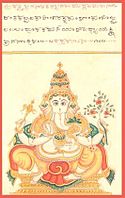
|
atha kShipragaNapatidhyAnaM || mudgalapurANE ||
daMtakalpalatApAsha |
ratnakuMbhAMkushOjvalaM |
baMdhUkakamanIyAbhaM |
dhyAyEtkShipragaNAdhipaM ||10|| raktavarNaH
He has four arms. He is red in colour. His hands show the single tusk, the elephant goad, the creeper of the votive tree (kalpalatâ), the noose. With the end of his trunk, he carries the stone cup full of precious stones (ratnakumbha).
|
Heramba Gaṇapati
"Mother's Beloved Son" Ganapati
|

|
atha hEraMbagaNapatidhyAnaM || mudgalapurANE ||
abhayavaradahastaM pAshadaMtAkShamAlAsRuNiparashudadhAnaM mudgaraM mOdakaM ca |
PalamadhigatasiMhaH paMcamAtaMgavaktrO |
gaNapatiratigauraH pAtu hEraMbanAmA || 11 || gauravarNaH
The five-headed Ganapati riding the lion. He has ten arms. He is dark in colour. His first hand shows the movement of lack of fear (abhaya), the others hold the rosary, the citron, the club, the elephant goad, the noose, the axe, the kadabu cake, the single tusk; his tenth hand shows the movement which bestows boons (varada).
|
Lakshmī-gaṇapati/ Śri Gaṇapati
"Ganapati the Fortunate"
similar to Goddess Lakshmi
|
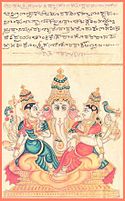
|
atha lakShmIgaNapatidhyAnaM || mudgalapurANE ||
bibhrANashshukabIjapUrakamiLanmANikyakuMbhAMkushA |
npApAshaM kalpalatAM ca KaDgavilasajjyOtissudhAnirJaraH |
shyAmEnAttasarOruhENa sahitaM dEvI dvayaM cAMtike |
gaurAMgo varadAnahastasahito lakShmIgaNEshovatAt || 12 || gauravarNaH
Embracing his wives Siddhi (Achievement) and Buddhi (Wisdom). He is white (fair) in colour. He has eight arms. His hands hold a pomegranate, a sword, the creeper of the votive tree, the elephant goad, the parrot, the noose, the jewel pot; his eighth hand bestows boons (varada).
|
Mahā Gaṇapati
"The Great Ganapati"
|

|
atha mahAgaNapatidhyAnaM || mudgalapurANE||
hastIMdrAnanamiMducUDamaruNaCAyaM triNEtraM rasAdAshliShTaM priyayA sapadmakarayA svAMkastayA saMtataM|
bIjApUragadEkShukArmukalasaccakrAbjapAshOtphala |
vrIhyagrasvaviShANaratnakalashAnhastair^vahaMtaM bhajE ||13|| raktavarNaH
With a shakti, He has ten hands. He is red in colour. His hands hold the single tusk, the pomegranate, the club, the sugar-cane bow, the disc, the conch, the noose, the nocturnal lotus, the paddy ear, the jewels pot.
|
Vijaya Gaṇapati
"Ganapati the Victorious"
|

|
atha vijayagaNapatidhyAnaM ||mudgalapurANE ||
pAshAMkushasvadaMtAmraPalavAnAKuvAhanaH viGnaM nihaMtu nassarvaM |
raktavarNO vinAyakaH ||14 || raktavarNaH
Riding a rat which trots at a smart pace, He has four arms. He is red in colour. His hands hold the single tusk, the elephant goad, the noose and the mango.
|
Nṛtya Gaṇapati
"Ganapati the Dancer"
|

|
atha nRuttagaNapatidhyAnaM || mudgalapurANE ||
pAshAMkushApUpakuThAradaMta caMcatkarAkluptavarAMguLIyakaM |
pItaprabhaM kalpatarOradhastAM |
bhajAmi nRuttOpapadaM gaNEshaM || 15 || pItavarNaH
Dancing under the boon-tree, He has four arms. He is golden in colour. His hands hold the single tusk, the elephant goad, the noose, the axe (parashu) or the hatchet (kuthâra). The dhyâna sloka specifies that one of the four hands can show a cake apûpa.
|
Ūrdhva Gaṇapati
"The Elevated Ganapati"
|
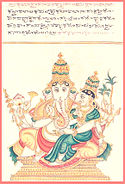
|
atha UrdhvagaNapatidhyAnaM || mudgalapurANE ||
kalhArashAlikamalEkShukacApabANa |
daMtaprarOhagadabhRutkanakOjjvalAMgaH |
AliMganOdyatakarO haritAMgayaShTyA |
dEvyA karOtu shubhamUrdhvagaNAdhipomE ||16|| kanakavarNaH
Seated with his Shakti on his left thigh, He has eight arms. He is golden in colour. His hands hold the single tusk, the arrow-flower, the daylight lotus, the blue lily (kalhara), the sugar-cane bow, the paddy ear, the club; his last hand claps the goddess. The extremity of his trunk is rolled around the right breast of the goddess.
|
Ekākshara Gaṇapati
Ganapati identified with "Single Syllable"(gaṃ).
|

|
atha EkAkSharagaNapatidhyAnaM || mudgalapurANE ||
raktO raktAMgarAgAMshukakusumayutastuMdilashcaMdramauLe |
nesatraiyusaktastribhirvAmanakaracaraNo bIjapUraM dadhAnaH |
hastAgrakluptapAshAMkusharadavaradO nAgavaktrOhibhUShO |
dEvaH padmAsanasthO bhavatu suKakarO bhUtaye viGnarAjaH ||17|| raktavarNaH
He has four arms. He is red in colour. His hands hold the single tusk, the elephant goad, the noose and the cake modaka. Sometimes, he wears, with the extremity of his trunk (bîjapûra).
|
Vara Gaṇapati
The "Boon-giver" Ganapati
|

|
atha varagaNapatidhyAnaM || mudgalapurANE ||
siMdUrAbhamibhAnanaM triNayanaM hastE ca pAshAMkushau |
bibhrANaM madhumatka pAlamanishaM sAdhviMdumauLiM bhajE ||
puShTyAshliShTatanuM dhvajAgrakarayA padmOllasaddhastayA |
tadyOnyAhitapANimAttavasumatpAtrOllasatpuShkaraM ||18|| raktavaraNaH
With a shakti seated on his left thigh, He has four arms. He is red in colour. His first three hands hold the elephant goad, the skull filled with liquor (madhumatkapâla) and the noose. The fourth hand creeps between the thighs of the goddess who holds a lotus and a banner.
|
Tryakshara Gaṇapati
Lord "of the Three-letters A+U+M" Ganapati
|

|
atha tryakShagaNapatidhyAnaM || mudgalapurANE ||
gajEMdravadanaM sAkShAccalatkarNaM sacAmaraM |
hEmavarNaM caturbAhuM |
pAshAMkushadharaM varaM |
svadaMtaM dakShiNE hastE |
savyE tvAmraPalaM tathA |
puShkarE mOdakaM caiva |
dhArayaMtaH manusmarEt ||19|| svarNavarNaH
He has four arms. His hands hold the single tusk, the elephant goad, the noose and the mango. He holds the cake modaka with the trunk end.
|
Kshirpra Prasāda Gaṇapati
Ganapati the "Quick-Rewarder"
|

|
atha kShipraprasAdagaNapatidhyAnaM || mudgalapurANE ||
dhRutapAshAMkushakalpalatAsvaradashca bIjapUrayutaH |
shashishakalakalitamaulistrilOcanO ruNashca gajavadanaH |
bhUsurabhUShadIptO bRuhadudaraH padma viShvarollasitaH |
viGnapayOdharapavanaH karadhRutakamalassadAstu mE bhUtyai ||20|| aruNavarNaH
He has six arms. He is red in colour. His hands hold the single tusk, the elephant goad, the lotus, the creeper of the votive tree (kalpalatâ), the noose, the lemon.
|
Haridrā Gaṇapati
"The curcuma-colored Ganapati".
|
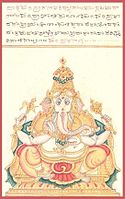
|
atha haridrAgaNapatidhyAnaM || mudgalapurANE||
haridrAbhaM caturbAhuM |
haridrAvadanaM prabhuM |
pAshAMkushadharaM dEvaM |
mOdakaM daMtamEva ca |
bhaktAbhayapradAtAraM |
vaMdE viGnavinAshanaM ||21|| haridrAvarNaH
He has four arms. He is yellow in colour. His hands hold the single tusk, the elephant goad, the noose and the cake modaka
|
Ekdanta Gaṇapati
"The Single Tusked Ganapati".
|

|
atha EkadaMtagaNapatidhyAnaM || mudgalapurANE|
laMbOdaraM shyAmatanuM gaNEshaM |
kuThAramakSha srajamUrdhva gAtraM |
salaDDukaM daMtamadhaH karAbhyAM |
vAmEtarAbhyAM ca dadhAnamIDE ||22|| shyAmavarNaH
He has four arms. He is blue in colour. His hands hold a large tusk, a rosary, a hatchet (kuthâra) and the small ball of sweets (laddu).
|
Sṝishṭi Gaṇapati
"Ganapati the Creator",
|

|
atha sRuShTigaNapatidhyAnaM || mudgalapurANE||
pAshAMkushasvadaMtAmra|
phalavAnAKuvAhanaH |
viGnaMnihaMtu nashyONa|
ssRuShTi dakShOvinAyakaH ||23|| raktavarNaH
Riding a big rat, He is red in colour. He has four arms. His hands hold the single tusk, the elephant goad, the noose and the mango.
|
Uddaṇḍa Gaṇapati
"Ganapati the Unchained",
|

|
atha uddaMDagaNapatidhyAnaM ||mudgalapurANE ||
kalhArAMbuja bIjapUraka gadAdaMtEkShucApaM sumaM |
bibhrANO maNikuMbhashAli kalashau pAshaM sRuNiM cAbjakaM |
gaurAMgyA rucirAraviMda karayA dEvyA samAliMgita |
shshoNAMgashshubhamAtanOtu bhajatA muddaMDaviGnEshvaraH ||24|| raktavarNaH
With his Shakti seated on his left thigh, He has twelve arms. He is red in colour. His hands hold the single tusk, the club, the nocturnal lotus, the noose, the paddy ear, the elephant goad, the washing pot (kamandalu), the sugar-cane bow, the disc, the daylight lotus, the conch and the pomegranate. His trunk is placed on the top of the goddesse's breast or, sometimes, maintains a jewels pot (manikumbha).
|
Ṝiṇamochana Gaṇapati
"Ganapati the liberator from debts"
|

|
atha RuNamOcanagaNapatidhyAnaM ||mudgalapurANE||
pAshAMkushau daMtajaMbU |
dadhAnaH sphaTikaprabhaH |
raktAMshukO gaNapati |
rmudE syAdRuNamOcakaH ||25|| shvEtavarNaH
Ganapati seated on a large lotus with his Shakti. He removes the impediment. He has four arms. He is white in colour. His first hand show the movement to bestow boons (varada); the three others hold the elephant goad, the noose and the bowl of sugared rice (pâyasapâtra).
|
Ḍhuṇḍhi Gaṇapati
"The Ganapati Sought After"
|

|
dhuMDigaNapatidhyAnaM || mudgalapurANE ||
akShamAlAM kuThAraM ca |
ratnapAtraM svadaMtakaM |
dhattE karairviGnarAjO |
dhuMDinAmA mudestu naH ||26|| aucityAdraktavarNaH
He has four arms. His hands hold the single tusk, the rosary (rudrAkSha), the hatchet (kuthâra) (an axe ) and the pot of jewels (ratnapâtra). (Red Color).
|
Dvimukha Gaṇapati
"Two-faced Ganapati"
|

|
atha dvimuKagaNapatidhyAnaM | mudgalapurANE |
svadaMtapAshAMkusharatnapAtraM |
karairdadhAnO harinIlagAtraH |
ratnAMshukO ratnakirITamAlI |
bhUtyai sadA bhavatu mE dvimuKO gaNEshaH | hasuruvarNaH
He holds in his hands his own tusk, a noose, a hook and a pot full of gems. His body complexion is greenish blue and he is wearing a red colored robe. A gem studded crown embellishes his head.
|
Trimukha Gaṇapati
"Three-faced Ganapati"
|

|
atha trimuKagaNapatidhyAnaM | mudgalapurANe |
shrUmattIkShNa shiKAMkushAkSha varadAndakShE dadhAnaH karaiH |
pAshaMcAmRuta pUrNakuMbhamabhayaM vAmE dadhAnO mudA |
pIThE svarNamayAraviMda vilasatsatkarNikA bhAsure |
svAsInastrimuKaH palAsharucirO nAgAnanaH pAtu naH | raktavarNa |
He has six arms. He carries in two of his right hands very sharp elephant goad, a rudrâksha rosary and is holding another hand in boon bestowing gesture (varada). He carries in two of his left hands a noose, an urn full of celestial nectar (amruta) - ambrosia pot (amritakumbha) and is holding another hand in gesture of bestowing fearlessness (abhaya). He is seated on shining golden throne with lotus in the center. He has three eyes with elephantine face and he effulgent like the flame of forest flower (bastard teak/butea frondosa). (Red color).
|
Siṇha Gaṇapati
"The Lion Ganapati".
|

|
atha siMhagaNapatidhyAnaM | mudgalapurANE |
vINAM kalpalatAmariM ca varadA dakShE vidhattE karai
vAsamE tAmarasaM ca ratnakalashaM sanmaMjarIM cAbhayaM |
shuMDAdaMDalasanmRugEMdravadanaM shaMKEMdugaurashshubhO |
dIvyadratnanibhAMshukOgaNapatiH pAyadapAyatsa naH ||29|| shvEtavar^NaH
He has eight arms. He is white in colour He is holding in his right hands a vîna (Indian lute), a creeper of votive tree - kalpavRukSha ( Tree which can cure all diseases), a discus and another held in a gesture of granting boons (varada). He is holding in his left hands a lotus, a pot of gems, a flower bunch and another held in a gesture of granting fearlessness (abahaya). He is lion faced with an elephant trunk and shining. His body is shining like a white conch and moon. He is wearing a gem studded shining robe.
|
Yoga Gaṇapati
"Ganapati the Ascetic".
|

|
atha yOgagaNapatidhyAnaM || mudgalapurANe ||
yOgArUDhO yOgapaTTAbhirAmO|
bAlAr^kAbhashcaMdranIlAMshukADhyaH|
pAshEkShvakShAnyOgadaMDaMdadhAnaH|
pAyAnnityaZM yOgaviGnEshvarOnaH ||30|| raktavarNaH
He has four arms. He is red in colour. His legs are surrounded with the meditation girdle (yogapatta). He is engrossed in yoga and is strapped in a yoga posture. He looks beautiful and shines like the rising morning sun. He is adorned with a colored robe which is shining like blue sapphire. His hands hold the rosary, the elbow-rest or the walking-stick (a yoga wand), the noose and the sugar-cane stalk.
|
Durga Gaṇapati
"Ganapati the Invincible"
similar the Goddess Durgâ.
|

|
atha durgAgaNApatidhyAnaM || mudgalapurANE ||
taptakAMcanasaMkAsha |
shcaShTahastOmahattanuH |
dIptAMkushaMsharaMcAkShaM |
daMttaMdakShEvahankaraiH |
vAmEpAshaMkArmukaMca |
latAM jaMbUMdadhatkaraiH raktAMshukassadAbhUyA ddurgAgaNapatirmudE ||31|| kanakavarNaH
His body glows like burnished gold (Golden Color). He has eight hands and massive body. He is holding a shining hook (Ankush), an Arrow, a rosary and a tusk with the four hands on the right side. He is holding a noose, a bow, a wish bestowing creeper and Rose Apple (Eugenia Jambolana) with the four hands on the left side. He is dressed in red clothes.
(According to another version, the Arrow is replaced by a noose)
|
Saṇkaṭahara Gaṇapati
"Ganapati - Dispeller of Troubles".
|

|
atha saMkaTaharagaNapatidhyAnaM || mudgalapurANE ||
bAlArkAruNakAMtirvAmEbAlAMvahannaMkE |
lasadiMdIvarahastAM |
gaurAMgIM ratnashObhADhyAM |
dakShEMkushavaradAnaM |
vAmEpAshaMcapAyasaMpAtraM |
nIlAMshukalasamAnaH |
pIThE padmAruNE tiShThan |
saMkaTaharaNaH pAyAtsaMkaTapUgEdgajAnanO nityaM | raktavarNaH
He has four arms. He is effulgent like the rising red sun (Red in Color). He has his wife (shakti) - who is carrying a beautiful lotus, glowing with radiance and bejeweled - sitting on his left lap. He is carrying in one of his right hand a hook (Ankusha) and with the other bestowing boon(varada). He is carrying in one of his left hand a rope(noose) and with the other a vessel brimming with sweet soup (Payasam). He is seated on a Red Lotus and wearing a blue robe.
(According to another version, the varada gesture and vessel of Payasam is replaced by the broken tusk and the rose-apple fruit.)
|
































